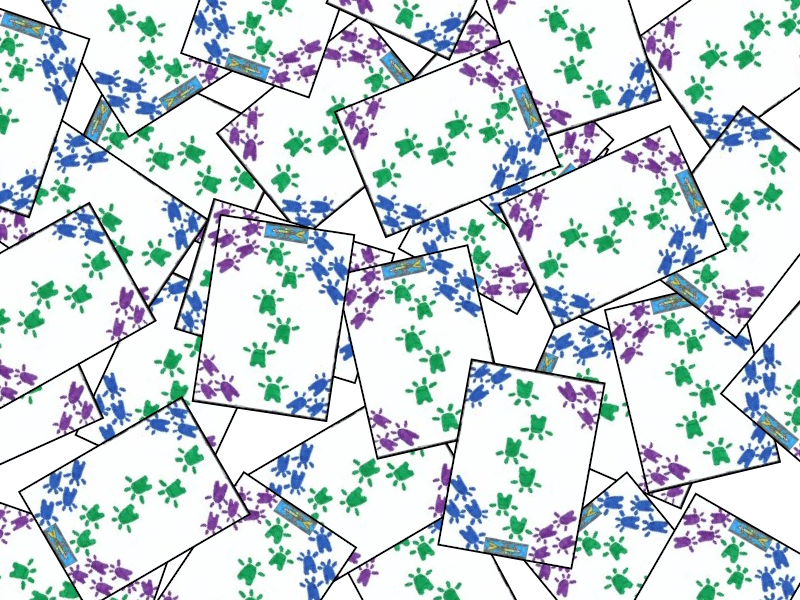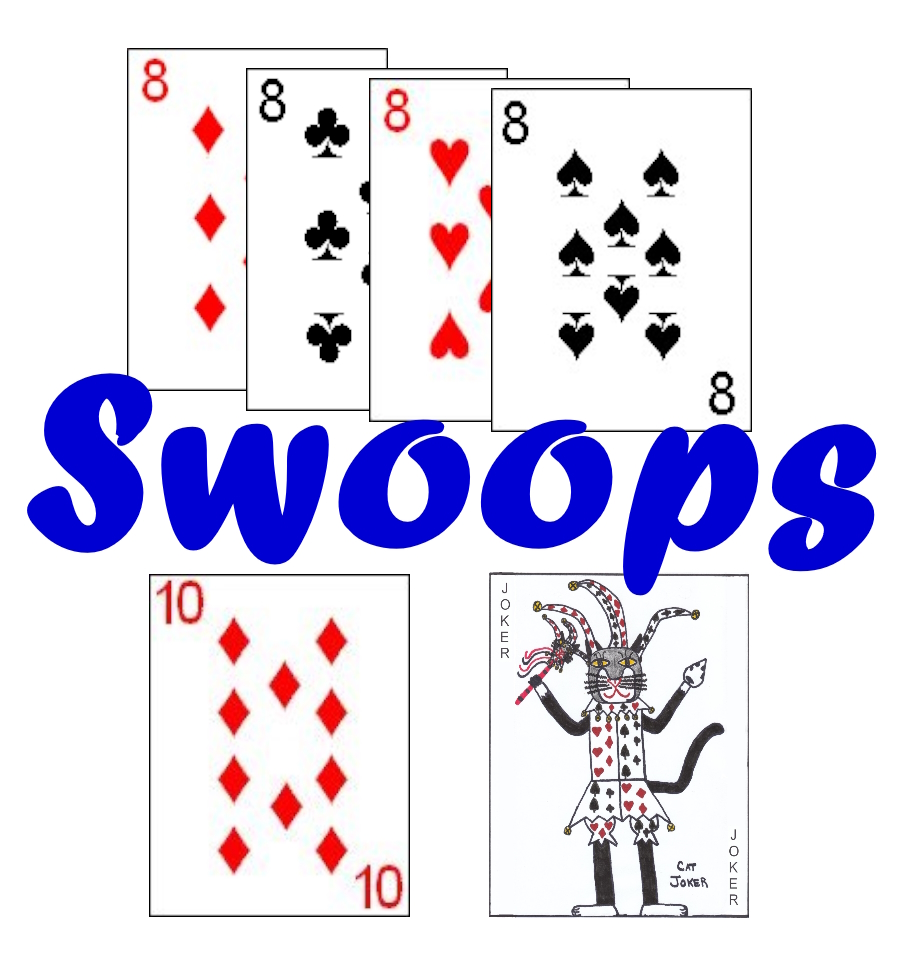Swoop is a newer card game of the shedding type, in which players attempt to be the first to deplete their nineteen card hands. Swoop is best for four players, but can be played by from three to eight players. The game uses three standard 52 card decks shuffled together and the addition of six total Jokers. The ranking of the cards as used for playing Swoop are as follows (from highest to lowest): King, Queen, Jack, 9, 8, 7, 6, 5, 4, 3, 2, Ace. It should be noted that the Jokers and tens are not included in this ranking, as all tens and Jokers are special cards called Swoop cards.
 Any random method (such as a draw for low cards) can be used to determine seating positions. Since players will be drawing the cards for their hand from a jumbled mix of cards, there is also no real concept of a dealer in Swoop. All three decks should be mixed together on the table, similar to a "wash" shuffle, to thus spread all the cards from the decks in a haphazard face-down collection of cards on the table. All players should help in thus mixing the cards. One player should also be selected to be the designated scorekeeper for the game.
Any random method (such as a draw for low cards) can be used to determine seating positions. Since players will be drawing the cards for their hand from a jumbled mix of cards, there is also no real concept of a dealer in Swoop. All three decks should be mixed together on the table, similar to a "wash" shuffle, to thus spread all the cards from the decks in a haphazard face-down collection of cards on the table. All players should help in thus mixing the cards. One player should also be selected to be the designated scorekeeper for the game.
Once the cards are thus thoroughly mixed and scattered about the table, each player then draws nineteen face-down cards from the table to form their hand. The player should not yet look at the cards drawn, keeping these cards in a face-down pile in front of themself. Each player should then select any four cards, unseen, from his pile and place them in front of himself, face-down. He then takes four more cards for his hand, and places one card face-up on top of each of his face-down cards. He may then pick up the remaining 11 cards in his hand. A players hand consists of all cards in the hand, and those on the table. However, the face-down cards are not available for play until the card on top has been previously played. These cards also, always remain face-down and the player may never look at these cards until he picks them up to play to the center of the table on his turn.
Before actual play, each player then draws one card from the remaining mixed cards in the middle of the table. Any players drawing cards of equal rank should put that card back into the pile and draw another. Whichever player ends up drawing the highest ranked card has the first turn, with the turns then rotating in a clockwise direction around the table. The cards drawn for determining the first player should be replaced back into the mixed cards, and all these cards pushed aside, and not used again during the current hand.
The first player may then play one or more cards from his hand. However, all cards played must be of the same rank. He may play from a combination of the face-up cards in front of him and cards from his hand.
After this player makes his play, the next player, in a clockwise direction then has his turn. This player then also makes a play to the table. He may play from a combination of his table cards and cards from his hand. This player also plays one or more cards, all of the same rank. However, the rank of the card or cards played must be of the same rank or lower than the rank of the card or cards played by the previous player. If he is unable (or elects not to) play such a card, he may play a higher ranked card to the table. However, in this event, he must pick up the entire pile of cards in the center of the table (including his played card) adding them into his hand. If a player is forced (or chooses) to thus pick up the pile, his turn immediately ends and the turn rotates to the next player in turn, who may then make a play of one or more cards all of the same rank, but of any such rank.
 As soon as four equally ranked cards (i.e. four Kings or four eights) have been played to the table (called a Swoop), all these cards are then removed (or swooped) from the table, and out of play. The player who played the fourth such card may then play again, playing one or more cards to the table of any matching rank.
As soon as four equally ranked cards (i.e. four Kings or four eights) have been played to the table (called a Swoop), all these cards are then removed (or swooped) from the table, and out of play. The player who played the fourth such card may then play again, playing one or more cards to the table of any matching rank.
On his turn, if a player has any of his originally face-down cards uncovered (the card on top has been previously played) he may play that card to the table on his turn. If the card is higher than those played by the previous player, he must then take the pile into his hand as usual, ending his turn. However, if the card is equal or lower than the last lay (or it is the first play of a new series), the player may play any other cards of that same rank he has in his hand (or in his face-up table cards).
A player may also, on his turn, if playing one of his face-up cards, may elect to also play the face-down card beneath it. However, if the face-down card beneath it is played, and it is a higher value card than the face-up card played to the table, he must then take the center pile into his hand, and end his turn. However, if the face-down card is lower or equal than the played card, he may then play another face-down card if it is not covered by another face-up card. He can continue playing from his face-down cards in this way, until he elects to stop or plays a card higher than the originally played face-up card.
In addition, on his turn, if a player has a Joker or ten (the "Swoop cards"), he may thus play this card to any combination already on the table to create a Swoop. This card and the rest of the pile are swooped away, out of play, and the player may then begin the next series of play with one or more cards, all in the same rank, of any rank.
Once any player manages to legally play his last card on his turn, the hand immediately ends and scoring for the hand occurs. The player who managed to play his last card scores zero points, for the round, but each other player earns a number of points based on all their unplayed cards (both in the hand and on the table face-up and face-down). Each card has a specific scoring value that is added to that player's ongoing accumulated score:
| Card | Point Value |
|---|---|
| Ace | 1 Point Each |
| 2, 3, 4, 5, 6, 7, 8, 9 | Value marked on card |
| Jack, Queen, King | 10 Points Each |
| Swoop Cards (Joker, 10) | 50 Points Each |
These points are accumulated for each player from hand to hand. At the end of a hand, if found that one or more players has a score equal to or greater than 500 points, the game immediately ends with the player having the lowest total score declared the winner.